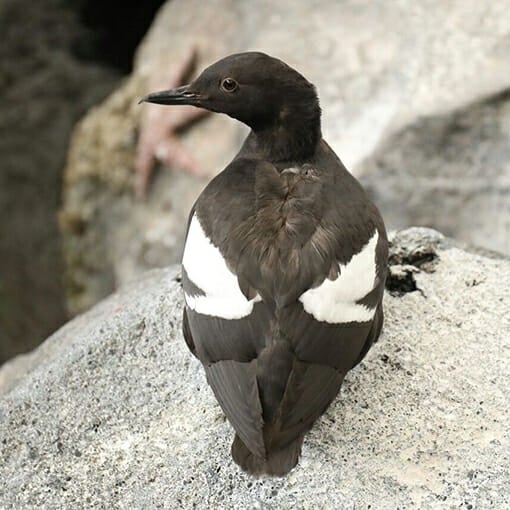-
Size
12-14 inches (30-36 cm) long -
Diet
Small fish and invertebrates -
Range
North Pacific -
Habitat
Rocky coastlines and inshore waters
Physical Characteristics
- Coloration is dark brown to black with white patches on wings in summer; white with grey and black back in winter. Has red legs and webbed feet. Also features a thin, straight bill and a long, thin neck.
- Common length of 12-14 inches (30-36 cm).
- Common wingspan of 22-23 inches (56-58 cm).
- Common weight of 16-19 oz. (450-540 g).
- Juveniles are covered with black down feathers.
Animal Fact
Unlike most auks, the pigeon guillemot will use its feet to propel itself while diving underwater, as well as its wings.
Diet / Feeding
- Diet consists of small fish and invertebrates.
- Hunts by diving and searching the sea floor for food.
- Uses wings to swim and feet to steer. Also uses feet for propulsion, unlike most auks.
- Can dive as deep as 150 feet (46 m); typically dives between 30 and 65 feet deep (9-20 m).
Range / Habitat
- The pigeon guillemot occurs in the North Pacific from Russia’s Kuril Islands to Eastern Siberia and from western Alaska to Southern California.
- Found along rocky coastlines and inshore waters.
Reproduction & Growth
- Monogamous; pairs may build nests as part of a colony or by themselves.
- Breeds on rocky cliffs and islands; nests located in crevices, caves or among rocks.
- Reaches maturity between three and five years old.
- Participates in mating displays including chasing, circling and touching bills.
- Females lay one or two cream-colored or pale bluish-green eggs with grey and brown spots.
- Both males and females incubate eggs for a total of 26-32 days.
Conservation Status
- “Least Concern” on the IUCN Red List.
Additional Information
- Member of the auk family, Alcidae.
- Both males and females feed hatchlings.
- Juveniles leave the nest 29-54 days after hatching.
- Pigeon guillemots in the northernmost parts of their range move south in winter to the edge of pack ice. Birds in the central part of their range typically remain in that region. Birds in the southernmost part of their range may migrate north after breeding.
- The oldest recorded pigeon guillemot was at least 15 years old.






